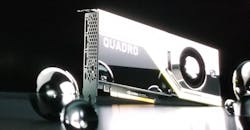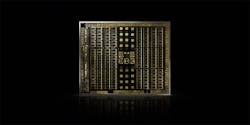NVIDIA’s announcement by CEO Jensen Huang at this year’s SIGGRAPH conference built on its GTC 2018 announcement on ray tracing. The ray-tracing technology brings photorealistic rendering to graphics that can be used in applications from movies to virtual-reality architectural presentations. Ray-tracing support was provided by NVIDIA’s Tesla V100, which was also designed to work with NVIDIA’s NVLINK switch. This allowed multiple general-purpose GPUs (GPGPUs) to be combined into a single compute engine—great for servers, but a bit heavyweight for a workstation.
1. With just a single GPU, the Quadro RTX 8000 is able to provide real-time ray tracing.
NVIDIA’s Quadro RTX 8000 delivers real-time ray tracing in a single PCI Express card (Fig. 1). The card contains a single Turing-architecture GPGPU with 48 GB of DRAM. The Turing architecture incorporates three types of cores: CUDA cores, Tensor AI cores, and ray-tracing cores. These operate in parallel.
The chip has 4608 CUDA cores and 576 Tensor cores (Fig. 2). It can deliver 10 GigaRays/s along with 16 TFLOPS and 16 TIPS (tera-integer operations). The Tensor cores offer 500 trillion Tensor operations/s. In addition, an NVLINK interface on the chip will allow doubling of memory and computational power by linking two boards together.
2. The first Turing architecture chip includes three types of cores: CUDA, ray tracing, and Tensor AI cores.
One of the reasons for including the Tensor cores is to augment the ray-tracing support by implementing AI-accelerated denoisers. These can essentially finish up a ray-traced image to provide a higher-quality image while requiring less computational power. The combination of ray tracing and Tensor cores enable high-resolution, real-time, ray-traced rendering.
The Quadro RTX has two siblings. The Quadro RTX 6000 reduces the memory to 24 GB, while the RTX 5000 cuts that to 16 GB. The latter also uses a chip with 3072 CUDA cores and 384 Tensor cores.
All of the boards provide the usual graphic outputs like HDMI and DisplayPort. They also support the new USB Type-C VirtualLink alternate mode. The VirtualLink Consortium’s VirtualLink targets augmented-reality (AR) and virtual-reality (VR) headsets. A single cable provides video and power along with a USB interface. The AR/VR supports features like variable rate shading, multi-view rendering, and VRWorks audio.
Real Time Means Real Change
Jensen’s presentation was very impressive because the 8K videos shown were all rendered in real time (Fig. 3). The platforms support AR and VR applications, which means applications that would normally have to render a movie for viewing at a later time can now do this in real time. Thus, an application can operate with different parameters. For example, a car buyer could specify the options, colors, and so on, and then take it for a virtual test drive with a photorealistic view of the interior and exterior of the car along with the virtual environment where it would be driven.
3. The photorealistic video presentations were all rendered in real time.
Other possible scenarios include architectural and interior design. The ability to render any type of lighting is key to these applications so that the virtual rendering matches reality. Though current tools often provide proper space and sizing while rendering similar colors, they lack photorealistic lighting. That’s because global illumination is hard without ray-tracing support. NVIDIA’s hardware and software handle complex scenarios such as diffuse reflections, caustic rendering, and refraction.
The platform supports interface standards like OptiX and Microsoft DirectX Raytracing (DXR). The boards are already in the hands of more than 30 software vendors, and they’re already delivering support for their applications. This includes gaming engines like Epic’s Unreal Engine.
The boards are a bit expensive for all but high-end gamers. The Quadro RTX family will be a boon for virtual cinematography, making it possible to create high-quality, high-resolution videos with high-end workstations instead of server farms. OEM workstation vendors like Dell EMC, HPE, HPI, and Lenovo have systems that support NVIDIA’s latest boards. NVIDIA also has its own server that includes eight boards organized in four pairs; each pair is connected using NVLink.
The Quadro RTX 8000 is priced at $10,000. The RTX 6000 and RTX 5000 go for $6,300 and $2,300, respectively.





